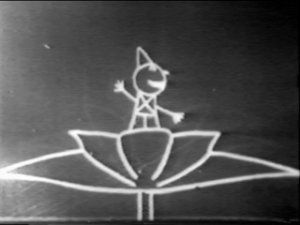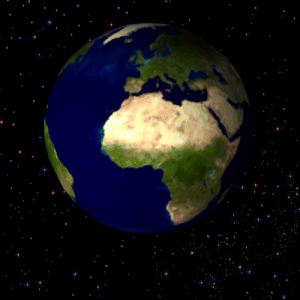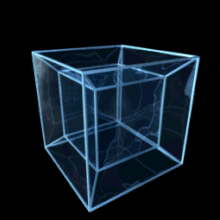Early examples
Main article: History of animation
Early examples of attempts to capture the phenomenon of motion drawing can be found in paleolithic cave paintings, where animals are depicted with multiple legs in superimposed positions, clearly attempting to convey the perception of motion.
A 5,000 year old earthen bowl found in Iran in Shahr-i Sokhta has five images of a goat painted along the sides. This has been claimed to be an example of early animation.[1] However, since no equipment existed to show the images in motion, such a series of images cannot be called animation in a true sense of the word.[2]
A Chinese zoetrope-type device had been invented in 180 AD.[3] Thephenakistoscope, praxinoscope, and the common flip book were early popular animation devices invented during the 19th century.
These devices produced the appearance of movement from sequential drawings using technological means, but animation did not really develop much further until the advent of cinematography.
There is no single person who can be considered the "creator" of film animation, as there were several people ẁorking on projects which could be considered animation at about the same time.
Georges Méliès was a creator of special-effect films; he was generally one of the first people to use animation with his technique. He discovered a technique by accident which was to stop the camera rolling to change something in the scene, and then continue rolling the film. This idea was later known as stop-motion animation. Méliès discovered this technique accidentally when his camera broke down while shooting a bus driving by. When he had fixed the camera, a hearse happened to be passing by just as Méliès restarted rolling the film, his end result was that he had managed to make a bus transform into a hearse. This was just one of the great contributors to animation in the early years.
The earliest surviving stop-motion advertising film was an English short by Arthur Melbourne-Cooper called Matches: An Appeal (1899). Developed for the Bryant and May Matchsticks company, it involved stop-motion animation of wired-together matches writing a patriotic call to action on a blackboard.
J. Stuart Blackton was possibly the first American film-maker to use the techniques of stop-motion and hand-drawn animation. Introduced to film-making by Edison, he pioneered these concepts at the turn of the 20th century, with his first copyrighted work dated 1900. Several of his films, among them The Enchanted Drawing (1900) and Humorous Phases of Funny Faces (1906) were film versions of Blackton's "lightning artist" routine, and utilized modified versions of Méliès' early stop-motion techniques to make a series of blackboard drawings appear to move and reshape themselves. 'Humorous Phases of Funny Faces' is regularly cited as the first true animated film, and Blackton is considered the first true animator.
Another French artist, Émile Cohl, began drawing cartoon strips and created a film in 1908 called Fantasmagorie. The film largely consisted of a stick figure moving about and encountering all manner of morphing objects, such as a wine bottle that transforms into a flower. There were also sections of live action where the animator’s hands would enter the scene. The film was created by drawing each frame on paper and then shooting each frame onto negative film, which gave the picture a blackboard look. This makes Fantasmagorie the first animated film created using what came to be known as traditional (hand-drawn) animation.
Following the successes of Blackton and Cohl, many other artists began experimenting with animation. One such artist was Winsor McCay, a successful newspaper cartoonist, who created detailed animations that required a team of artists and painstaking attention for detail. Each frame was drawn on paper; which invariably required backgrounds and characters to be redrawn and animated. Among McCay's most noted films are Little Nemo (1911), Gertie the Dinosaur (1914) andThe Sinking of the Lusitania (1918).
The production of animated short films, typically referred to as "cartoons", became an industry of its own during the 1910s, and cartoon shorts were produced to be shown in movie theaters. The most successful early animation producer was John Randolph Bray, who, along with animator Earl Hurd, patented the cel animation process which dominated the animation industry for the rest of the decade.
[edit]Techniques
[edit]Traditional animation
Main article: Traditional animation
Traditional animation (also called cel animation or hand-drawn animation) was the process used for most animated films of the 20th century. The individual frames of a traditionally animated film are photographs of drawings, which are first drawn on paper. To create the illusion of movement, each drawing differs slightly from the one before it. The animators' drawings are traced or photocopied onto transparent acetate sheets called cels, which are filled in with paints in assigned colors or tones on the side opposite the line drawings. The completed character cels are photographed one-by-one onto motion picture film against a painted background by a rostrum camera.
The traditional cel animation process became obsolete by the beginning of the 21st century. Today, animators' drawings and the backgrounds are either scanned into or drawn directly into a computer system. Various software programs are used to color the drawings and simulate camera movement and effects. The final animated piece is output to one of several delivery media, including traditional 35 mm film and newer media such as digital video. The "look" of traditional cel animation is still preserved, and the character animators' work has remained essentially the same over the past 70 years. Some animation producers have used the term "tradigital" to describe cel animation which makes extensive use of computer technology.
Examples of traditionally animated feature films include Pinocchio (United States, 1940), Animal Farm (United Kingdom, 1954), and Akira(Japan, 1988). Traditional animated films which were produced with the aid of computer technology include The Lion King (US, 1994) Sen to Chihiro no Kamikakushi (Spirited Away) (Japan, 2001), and Les Triplettes de Belleville (2003).
- Full animation refers to the process of producing high-quality traditionally animated films, which regularly use detailed drawings and plausible movement. Fully animated films can be done in a variety of styles, from more realistically animated works such as those produced by the Walt Disney studio (Beauty and the Beast, Aladdin, Lion King) to the more 'cartoony' styles of those produced by theWarner Bros. animation studio. Many of the Disney animated features are examples of full animation, as are non-Disney works such asThe Secret of NIMH (US, 1982) and The Iron Giant (US, 1999), Nocturna (Spain, 2007)
- Limited animation involves the use of less detailed and/or more stylized drawings and methods of movement. Pioneered by the artists at the American studio United Productions of America, limited animation can be used as a method of stylized artistic expression, as inGerald McBoing Boing (US, 1951), Yellow Submarine (UK, 1968), and much of the anime produced in Japan. Its primary use, however, has been in producing cost-effective animated content for media such as television (the work of Hanna-Barbera, Filmation, and other TV animation studios) and later the Internet (web cartoons). Some examples are; Spongebob Squarepants (USA, 1999–present), The Fairly OddParents (USA, 2001–present) and Invader Zim (USA, 2001–2002, 2006).
- Rotoscoping is a technique, patented by Max Fleischer in 1917, where animators trace live-action movement, frame by frame. The source film can be directly copied from actors' outlines into animated drawings, as in The Lord of the Rings (US, 1978), used as a basis and inspiration for character animation, as in most Disney films, or used in a stylized and expressive manner, as in Waking Life (US, 2001) and A Scanner Darkly (US, 2006). Some other examples are: Fire and Ice (USA, 1983) and Heavy Metal (1981).
- Live-action/animation is a technique, when combining hand-drawn characters into live action shots. One of the earlier uses of it wasKoko the Clown when Koko was drawn over live action footage. Other examples would include Who Framed Roger Rabbit? (USA, 1988),Space Jam (USA, 1996) and Osmosis Jones (USA, 2002).
[edit]Stop motion
Main article: Stop motion
Stop-motion animation is used to describe animation created by physically manipulating real-world objects and photographing them one frame of film at a time to create the illusion of movement. There are many different types of stop-motion animation, usually named after the type of media used to create the animation. Computer software is widely available to create this type of animation.
- Puppet animation typically involves stop-motion puppet figures interacting with each other in a constructed environment, in contrast to the real-world interaction in model animation. The puppets generally have an armature inside of them to keep them still and steady as well as constraining them to move at particular joints. Examples include The Tale of the Fox (France, 1937), The Nightmare Before Christmas (US, 1993), Corpse Bride (US, 2005), Coraline (US, 2009), the films of Jiří Trnka and the TV series Robot Chicken (US, 2005–present).
- Puppetoon, created using techniques developed by George Pal, are puppet-animated films which typically use a different version of a puppet for different frames, rather than simply manipulating one existing puppet.
- Puppetoon, created using techniques developed by George Pal, are puppet-animated films which typically use a different version of a puppet for different frames, rather than simply manipulating one existing puppet.
- Clay animation, or Plasticine animation often abbreviated as claymation, uses figures made of clay or a similar malleable material to create stop-motion animation. The figures may have an armature or wire frame inside of them, similar to the related puppet animation (below), that can be manipulated in order to pose the figures. Alternatively, the figures may be made entirely of clay, such as in the films of Bruce Bickford, where clay creatures morph into a variety of different shapes. Examples of clay-animated works include The Gumby Show (US, 1957–1967) Morph shorts (UK, 1977–2000), Wallace and Gromit shorts (UK, as of 1989), Jan Švankmajer's Dimensions of Dialogue(Czechoslovakia, 1982), The Trap Door (UK, 1984). Films include Wallace & Gromit: The Curse of the Were-Rabbit, Chicken Run and The Adventures of Mark Twain.
- Cutout animation is a type of stop-motion animation produced by moving 2-dimensional pieces of material such as paper or cloth. Examples include Terry Gilliam's animated sequences from Monty Python's Flying Circus (UK, 1969–1974); Fantastic Planet (France/Czechoslovakia, 1973) ; Tale of Tales (Russia, 1979), The pilot episode of the TV series (and sometimes in episodes) of South Park (US, 1997).
- Silhouette animation is a variant of cutout animation in which the characters are backlit and only visible as silhouettes. Examples include The Adventures of Prince Achmed (Weimar Republic, 1926) and Princes et princesses (France, 2000).
- Model animation refers to stop-motion animation created to interact with and exist as a part of a live-action world. Intercutting, matte effects, and split screens are often employed to blend stop-motion characters or objects with live actors and settings. Examples include the work ofRay Harryhausen, as seen in films such Jason and the Argonauts (1961), and the work ofWillis O'Brien on films such as King Kong (1933 film).
- Go motion is a variant of model animation which uses various techniques to create motion blur between frames of film, which is not present in traditional stop-motion. The technique was invented by Industrial Light & Magic and Phil Tippett to create special effects scenes for the film The Empire Strikes Back (1980). Another example is the dragon named Vermithrax fromDragonslayer (1981 film).
- Object animation refers to the use of regular inanimate objects in stop-motion animation, as opposed to specially created items.
- Graphic animation uses non-drawn flat visual graphic material (photographs, newspaper clippings, magazines, etc.) which are sometimes manipulated frame-by-frame to create movement. At other times, the graphics remain stationary, while the stop-motion camera is moved to create on-screen action.
- Pixilation involves the use of live humans as stop motion characters. This allows for a number of surreal effects, including disappearances and reappearances, allowing people to appear to slide across the ground, and other such effects. Examples of pixilation include The Secret Adventures of Tom Thumb and Angry Kid shorts.
[edit]Computer animation
Main article: Computer animation
Computer animation encompasses a variety of techniques, the unifying factor being that the animation is created digitally on a computer.
[edit]2D animation
2D animation figures are created and/or edited on the computer using 2D bitmap graphics or created and edited using 2D vector graphics. This includes automated computerized versions of traditional animation techniques such as of tweening,morphing, onion skinning and interpolated rotoscoping.
Examples: Foster's Home for Imaginary Friends, Danny Phantom, Waltz with Bashir, The Grim Adventures of Billy and Mandy
[edit]3D animation
3D animation are digitally modeled and manipulated by an animator. In order to manipulate a mesh, it is given a digital skeletal structure that can be used to control the mesh. This process is called rigging. Various other techniques can be applied, such as mathematical functions (ex. gravity, particle simulations), simulated fur or hair, effects such as fire and water and the use of Motion capture to name but a few, these techniques fall under the category of 3d dynamics. Many 3D animations are very believable and are commonly used as Visual effects for recent movies.
[edit]Terms
- Photo realistic animation, is used primarily for animation that attempts to resemble real life. Using advanced rendering that makes detailed skin, plants, water, fire, clouds, etc. to mimic real life. Examples include Up (2009, USA), Kung-Fu Panda, Ice Age (2002, USA).
- Cel-shaded animation, is used to mimic traditional animation using CG software. Shading looked stark and less blending colors. Examples include, Skyland (2007, France), Appleseed(2007, Japan), The Legend of Zelda: Wind Waker (2002, Japan)
- Motion capture, is used when live action actors wear special suits that allow computers to copy their movements into CG characters. Examples include Polar Express (2004, USA),Beowulf (2007), Disney's A Christmas Carol (2009 USA), Avatar (2009, USA).
2D animation techniques tend to focus on image manipulation while 3D techniques usually build virtual worlds in which characters and objects move and interact. 3D animation can create images that seem real to the viewer.
[edit]Other animation techniques
- Drawn on film animation: a technique where footage is produced by creating the images directly on film stock, for example by Norman McLaren, Len Lye and Stan Brakhage.
- Paint-on-glass animation: a technique for making animated films by manipulating slow drying oil paints on sheets of glass, for example by Aleksandr Petrov.
- Erasure animation: a technique using tradition 2D medium, photographed over time as the artist manipulates the image. For example,William Kentridge is famous for his charcoal erasure films.
- Pinscreen animation: makes use of a screen filled with movable pins, which can be moved in or out by pressing an object onto the screen. The screen is lit from the side so that the pins cast shadows. The technique has been used to create animated films with a range of textural effects difficult to achieve with traditional cel animation.
- Sand animation: sand is moved around on a back- or front-lighted piece of glass to create each frame for an animated film. This creates an interesting effect when animated because of the light contrast.
- Flip book: A flip book (sometimes, especially in British English, called a flick book) is a book with a series of pictures that vary gradually from one page to the next, so that when the pages are turned rapidly, the pictures appear to animate by simulating motion or some other change. Flip books are often illustrated books for children, but may also be geared towards adults and employ a series of photographs rather than drawings. Flip books are not always separate books, but may appear as an added feature in ordinary books or magazines, often in the page corners. Software packages and websites are also available that convert digital video files into custom-made flip books.









No comments:
Post a Comment
Jayant Parkash Is Welcome All world to my blog